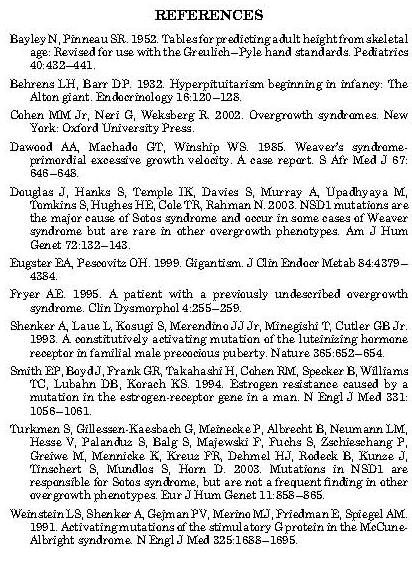Here is just a short post on the many types of conditions, disorders, and pathologies which can cause overgrowth, excessive height, and gigantism.
I took this information mainly from the article that was studying Siah Khan, entitled “Cranio-Spondylo-Tubular Dysostosis – A Unique Historic Iranian Giant “Siah-Khan Syndrome” – Report of an extremely rare or perhaps a unique case in the world from Iran”.
It was published in probably a scientific journal entitled “Genetics in the 3rd millennium, Vol. 8, No.2, Summer 2010”
In the article it is stated that these conditions lead to tall stature, but of course the tall stature is form a medical disorder.
1. The most common cause of pathologically tall stature is pituitary gigantism. – The excessive growth hormone, usually results from over- secretion by a group of somatotrope cells of anterior pituitary gland (somatotrope adenoma). The primary effect of the disease is excessive growth resulting in tallness (1, and 2). Tallness is accompanied by heavy, thick bones with large hands and feet and a heavy jaw. Once puberty is complete and adult height achieved, continued growth results in acromegaly. In this case diagnosis is not so difficult. By measuring blood growth hormone (GH) and insulin like growth factor 1 (IGF1), clinical impression can be confirmed.
2. There are some other very heterogeneous and very rare genetic and non-genetic conditions that overgrowth or tallness is a consistent finding in them (3, 4); such as
3. Precocious puberty
4. Extra sex chromosome syndromes (4),
5. Sotos syndrome (3, 5),
6. Beckwith-Wiedemann syndrome (3, 6),
7. Simpson- Golabi-Behmel syndrome (3, 7),
8. Marshal-Smith syndrome (3, 8),
9. …and some of the Craniotubular Dysostoses (3, 9, 14).
If you are a height increase or genetic researcher, I will list the articles and studies for reference below for you to find off of PubMed.
Note: On a personal note, I would also add the fact that maybe Weaver’s Syndrome, Proteus Syndrome, and Marfan’s Syndrome also all seem to lead to tall stature. This implies that we should be doing even more studying on all of these syndromes and disorders to find out what are the main link that connects all of these syndromes to lead to tall stature. It could just be one main link and cause or it could be from a multiple of causes.
References
1. Daniels GH, Martin JB. Growth hormone excess: Acromegaly and gigantism. In: Isselbacher KJ, Marhn J13. Harrison’s Principles of Internal Medicine. Vol 2 13th ed. McGraw Hill; 1994.p.1989-91.
2. Cohen P. Hyperpituitarism, tallstature, and overgrowth syndromes. In: Behrman R, Kliegman R, Jenson HB. Nelson’s textbook of Pediatrics. 16th ed. WB Saunders; 2000.p.1685-7.
3. Jones KL. Early overgrowth with associated defects. Syndromes In: Smith’s recognizable patterns of human malformation. 5th ed. WB Saunders; 1997.p.150-68. 4. Graham JM. Rimion DL. Abnormal body size and proportion; generalized overgrowth disorders. In:
Rimon DL, Conner JM, Pyeritz RE, et al. Emery and Rimoin’s principles and practice of medical genetics. Vol. 4th ed. Churchill livingstone;2002.p.1075-77.
5. Sotos J F, Dodge P R, Muirhead D, et al. Cerebral gigantism in childhood: a syndrome of excessively rapid growth with acromegalic features and a nonprogressive neurologic disorder. New Eng J Med 1964;271:109-16.
6. Beckwith J B. Macroglossia, omphalocele, adrenal cytomegaly, gigantism, and hyperplastic visceromegaly. Beckwith J Birth Defects 1969;5:188- 96.
7. Savarirayan R, Bankier A. Simpson-Golabi-Behmel syndrome and attention deficit hyperactivity disorder in two brothers. J Med Genet 1999;36:574-6.
8. Johnson JP, Carey JC, Glassy FJ, et al. Marshall- Smith syndrome: two cases reports and a review of pulmonary manifestations. Pediatrics 1983;71(2); 219-23.
9. Sillence DO. Craniotubular remodelling disorders. In: Rimon DC, Conner JM, Pyeritz RE, et al. Emery’s and Rimoins principles and practice of medical genetics. 4th ed. Churchill Livingstone;2002.p:4130-5.
10. Ayuk J, Sheppard MC. Growth hormone and its disorders. Postgrad Med J 2006;82(963):24-30.
11. Viljoen D, Beighton P. Marfan syndrome: a diagnostic dilemma. Clin Genet 1999;37(6):417-22. 12. Faravelli F. NSD1 mutations in Sotos syndrome. Am J Med Genet Semin Med Genet 2005;137(1):24- 31.
13. Endo F. Berardinelli lipodystrophy syndrome. Ryoikibetsu Shikogun Shirizu 2000; (30pt5):143-4. Review. Japanese.
14. Lachman RS. Skeletal dysplasias. In: Taybi H, Lachman RS. Editors. Radiology of Syndromes, Metabolic disorders, and skeletal dysplasias. 4th ed. Mosby;1996.p.791-802.
For an even greater collection on Studies and papers on abnormal and unique cases on overgrowth and gigantism I would list the references I also found from the paper on Zech Devits below which was entitled “A Provisionally Unique Syndrome Of Macrosomia, Bone Overgrowth, Macrocephaly, and Tall Stature” which I had found from the TallestMan.com website.

